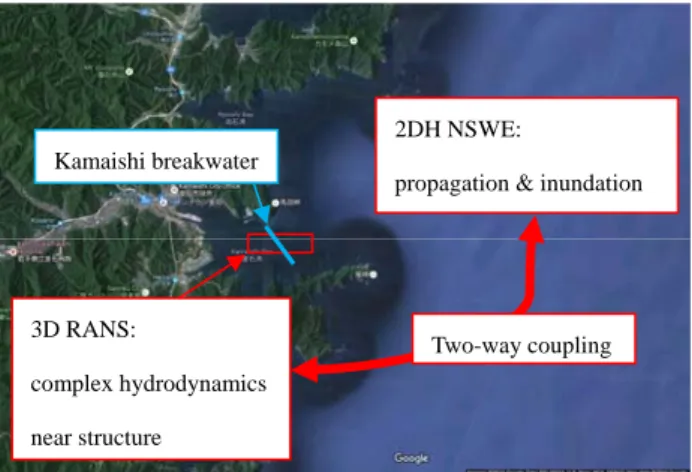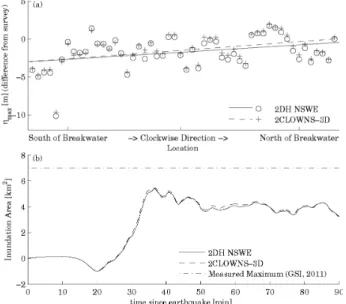C18
Hydrodynamics of Tsunami in the Vicinity of a Large Scale Breakwater
〇William J. PRINGLE・Nozomu YONEYAMA
Introduction
The large-scale offshore breakwater located at the entrance to Kamaishi Bay on the Sanriku ria coast of Japan was partially destroyed during the devastating 2011 Tohoku Earthquake Tsunami. However, the breakwater has been accredited with reducing inundation heights in the Kamaishi region by up to 40%.
It is of interest to detail the full three-dimensional (3D) hydrodynamics of the flow in the vicinity of the breakwater in order to better quantify the distribution of velocities, eddies, and bottom stresses. The effect of the breakwater on the flow structure and sediment transport issues in the bay is important for the design of ports and coasts. This study aims to address these two main points. In addition, a detailed estimation of the actual realistic forces and the distribution of these that the breakwater was subjected to should be estimated for improved design against failure. This study aims to address these issues through the use of a high-fidelity multiscale numerical simulation.
Numerical Model and Setup
In order to simulate the full 3D flow around the breakwater a 3D Reynolds-averaged Navier-Stokes (3D RANS) model is used. However, accurate wide-scale simulation is unattainable due to computational constraints and unreliable computations over large domains. Hence, propagation from the tsunami source to the breakwater and coastal inundation is modelled using an efficient horizontal two-dimensional shallow water equation (2DH NSWE) based model. These two models are coupled
together allowing for two-way exchange of information. The coupled model is abbreviated as 2CLOWNS-3D (2-way Coupled Long Wave to 3D RANS).
The 2011 Tohoku Earthquake Tsunami is simulated from the wave source all the way to the Kamaishi coast. The multiscale simulation consists of a total of five nested 2DH NSWE grids ranging from 1350 m to 10 m in resolution. A further 3D RANS grid with 10 m horizontal resolution and 2.50 – 1.25 m vertical resolution is adopted. The size and location of the RANS grid is indicated in Fig. 1 where the focus is on the flow through and around the breaking opening.
Fig. 1 Numerical model concept and location of the 3D RANS grid in
the vicinity of the Kamashi breakwater
Results and Discussion
Firstly, simulations using the pre-tsunami undamaged bathymetry of the breakwater are conducted. The maximum inundation heights at various locations and total inundation area are compared with survey measurements in Fig. 2. They are shown to be in reasonable agreement given the
2DH NSWE:
propagation & inundation
3D RANS:
complex hydrodynamics near structure
Kamaishi breakwater
uncertainties due to the large-scale breakwater involved. Furthermore, using the 2CLOWNS-3D model gives little difference compared with a simulation using only the 2DH NSWE model without the additional 3D RANS domain. This fact demonstrates the robustness of the coupling scheme.
Fig. 2 Comparison of simulated maximum inundation heights versus
survey results (a) and inundation area versus GSI estimates (b)
Secondly, the 3D hydrodynamics of the flow around the breakwater are analyzed. Fig. 3 shows how the maximum depth-averaged velocities, Umax are greater in the center of the jet in the 2CLOWNS-3D simulation while the velocities over the breakwater opening are larger in the 2DH NSWE model. This can be attributed to the vertical accelerations present as the tsunami flows over the breakwater. As such the flow becomes highly non-hydrostatic over the submerged caissons located at the breakwater opening in the 3D RANS domain as illustrated in Fig. 4. However, the 2DH NSWE cannot model vertical accelerations and assumes a hydrostatic pressure distribution. As a result it underestimates the velocity near the bed onshore of the breakwater and overestimates the change in free-surface at the breakwater section inducing a large depth-averaged velocity here. These differences may result in very
different estimates of the forces and moments on the submerged caissons as well as tsunami current distributions and shear stresses important for port safety and sediment transport estimates. Thus, use of the 2CLOWNS-3D model is highly recommended in analyzing flows around coastal structures such as the large-scale offshore breakwater in this study.
Fig. 3 Simulated maximum depth-averaged velocities in the 2DH
NSWE model (a) and 2CLOWNS-3D model (b)
Fig. 4 Vertical profiles of the horizontal velocity (a), vertical velocity

